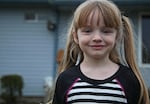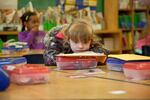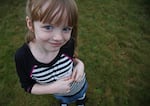The state of Oregon has set an ambitious goal to graduate 100 percent of high school students by the year 2025. OPB is following more than two dozen six and seven-year-olds who are in the class of 2025. For the next twelve years, OPB aims to follow these students, in school and at home. These are some of their stories from first grade.
It's reading time during an after-school program at Earl Boyles Elementary, so most of the first graders scramble for a seat on the brightly colored carpet.
Kaylie doesn’t join the jumble of cross-legged students in a semi-circle around their teacher. Instead, she quietly takes a seat in a plastic chair and folds her hands in her lap.
While her classmates squirm or giggle or poke each other, Kaylie faces forward and watches the teacher. Her face is a constellation of pale freckles fringed with long bangs. She looks small for her age, even sitting in the child-sized chair. She gets special permission to perch at the edge of the semi-circle, because she's not able to sit comfortably on the floor like the rest of her classmates. Seven-year-old Kaylie stands out from her classmates in a lot of ways, including her good classroom behavior. But she thinks a lot about the condition that keeps her outside the reading semi-circle. "What are some things that all humans have in common?" asks the teacher, as a preface to the book they're about to read.
"We all eat breakfast," says one student. "We all go to school!" suggests another. Kaylie raises her hand, and then realizing that no one else is waiting to be called on, she says in a soft voice, "We all go to the bathroom." Kaylie thinks about doing just that a lot. She has a rare congenital condition called Hirschsprung's Disease. It's a genetic disease of the intestine that makes it extremely difficult for solid waste to pass through the digestive tract. Because of the disease, she has to wear pull-up diapers and take a steady stream of laxatives.
Kaylie's mother, Alicia Smith, says she always knew there was something wrong. For most people with Hirschsprung's, the disease is recognized when they're infants. Kaylie wasn't diagnosed until she was three. As a toddler, Kaylie wouldn't go to the bathroom for days. When she finally did, her mom says she'd scream in pain. Again and again, Smith took Kaylie to doctors, but her symptoms were undiagnosed. One day four years ago, on the way home from what Smith describes as another frustrating doctor's appointment, they stopped in at a neighborhood convenience store. Suddenly, three-year-old Kaylie started throwing up and couldn't stop. A horrified store attendant called 911 after Kaylie began vomiting blood and feces. Kaylie spent the next 72 days in the hospital. After finally being correctly diagnosed with Hirschsprung's, she then underwent multiple surgeries to remove portions of her grayed, diseased intestine.
After that, Kaylie quickly became the focus of Smith’s already hectic life. Smith and her husband have been separated since Kaylie was one week old. At first, Smith depended heavily on her own mother, Kaylie's grandma, to help care for Kaylie, but she passed away when Kaylie was four. Sometimes, Smith’s cousin comes over and helps Kaylie with homework and teaches her geography. Since Smith doesn’t have a car, she has friends who offer to drive them to Kaylie’s appointments, or to go grocery shopping.
Kaylie has spent more than six months total in the hospital. Things are a little better now. Smith has learned how to treat her daughter's disease at home. As Kaylie grows, she'll need more surgeries, but right now she's too small. Her mom tells her that her abdominal scars are beautiful, and they're part of who she is. Last year, Kaylie missed more than a month of kindergarten. Most kids with that many absences begin to trail in school. Long-term studies have shown that chronic absenteeism in elementary school can be a warning sign for poor academic performance in later school years.

Seven-year-old Kaylie, on a day where she feels well. When Kaylie feels sick, she gets dark circles under her eyes.
Amanda Peacher / OPB
Kaylie rarely admits that she feels sick, but Smith has learned to read the signs. When Kaylie feels well, she's energetic, feisty, and helpful. But at a recent doctor's visit, she's lethargic and somber. She has dark shadows under her eyes. She's holding her mother's hand as the doctor talks.
After the exam, the pediatrician says that Kaylie needs a special three-day treatment to flush out her digestive system. Smith can try to administer the treatment at home. If that doesn’t work, Kaylie will be admitted to the hospital for the treatment.
"So we'll need to keep you home from school, baby, maybe starting Wednesday," Smith explains to Kaylie while they wait for paperwork and prescriptions. "I don't want to miss SUN!" says Kaylie. SUN, or "Schools Uniting Neighborhoods," is an after-school educational program, and it's one of Kaylie's favorite parts of the week. Smith hesitates. "Well, maybe we can keep you home starting Thursday." "Thursday is the Dr. Seuss reading party," says Kaylie. Smith sighs. They compromise: Kaylie will go to the reading party in the morning, and then come home for treatment.
Many days, Kaylie and her mom have to compromise on something related to Kaylie’s illness. Sometimes it’s getting Kaylie to take her medicine, or to go to doctor’s appointments. Sometimes it’s food: Kaylie lost a lot of her taste buds due to multiple anesthesia treatments before surgeries. Smith has to constantly beg her to eat.
But Smith rarely has to convince Kaylie to do schoolwork. Her teacher says Kaylie is doing well in every subject. Despite all her absences, Kaylie is ahead of her classmates. She's reading at a third grade level. She just finished a 190-page book. "It was easy because I really like the stories," she says. When her teacher asks what colors might spring flowers be, Kaylie doesn't suggest red or yellow, like her classmates. "Indigo!" she says. When she's the first to finish her math quiz, she's doesn't play with erasers or make faces at classmates. She fetches a book from the shelf and reads to herself while the rest of the students finish. For Kaylie, school is a place where she can succeed, though she is still nervous about being teased for wearing pull-ups. She's started to be more open about her disease, but she only talks about it with a small circle of close friends. She can't count on her health or her physical condition, but she can count on being great at addition and subtraction, and being one of the only kids in her class who reads chapter books.
This project is part of American Graduate — Let’s Make It Happen! — a public broadcasting initiative to address the drop out crisis, supported by the Corporation for Public Broadcasting.





